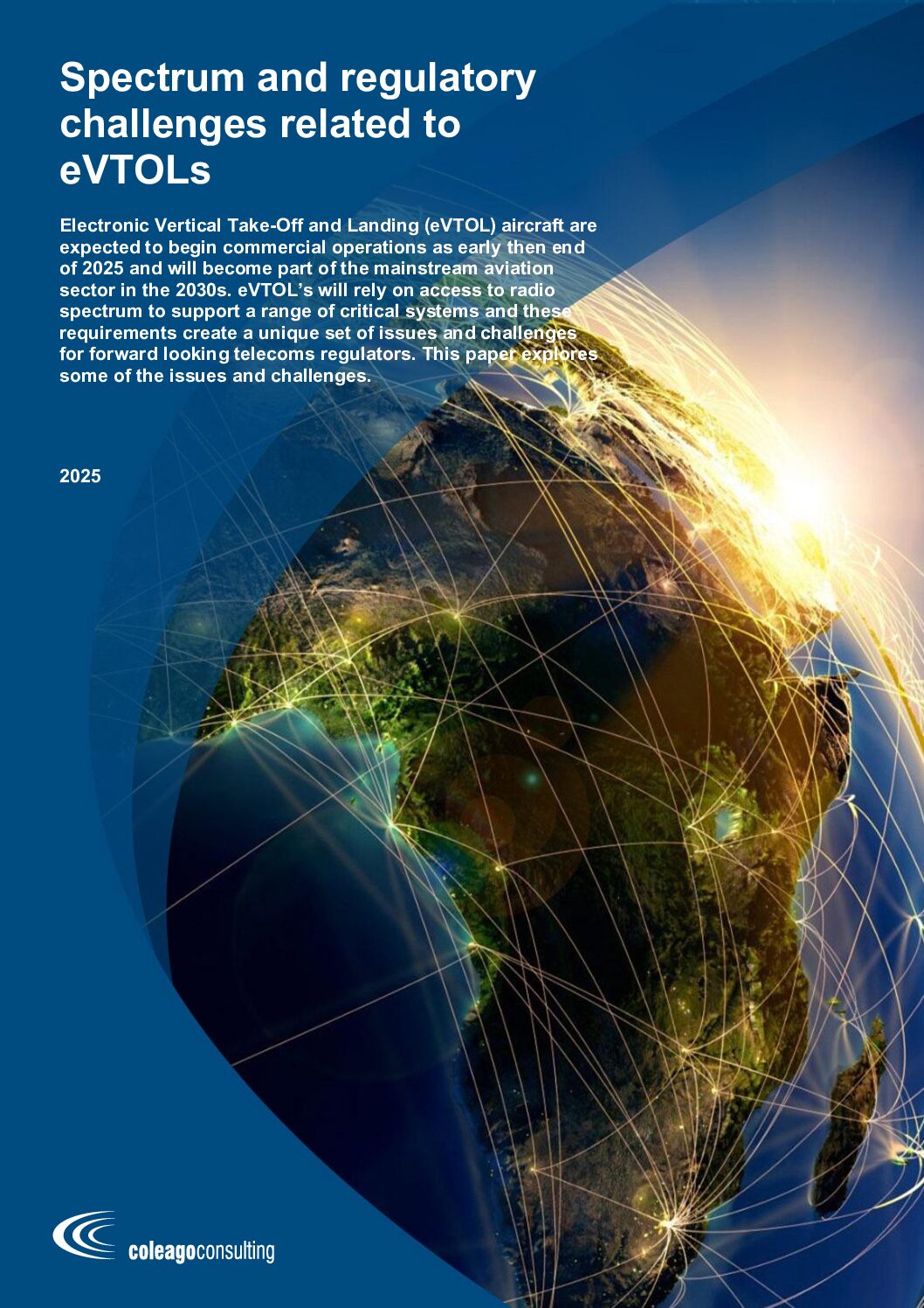Spectrum and Regulatory Challenges Related to eVTOLS
Electric Vertical Take-Off and Landing (eVTOL) aircraft are poised to revolutionise urban mobility, with commercial operations expected to begin as early as 2025 and significant growth anticipated by the 2030s.
The successful integration of eVTOLs into airspace and transportation networks hinges on resolving complex spectrum and regulatory challenges. This paper by Coleago Consulting, in collaboration with Cranfield University, outlines the key issues that national telecom and aviation regulators must address to facilitate safe, efficient and scalable eVTOL operations.

Key Challenges Identified
Spectrum Availability and Management
- eVTOL systems require access to highly reliable, low-latency spectrum for communication, navigation and safety-critical functions
- There is currently no globally harmonised spectrum for eVTOLs, risking potential interference issues
- New spectrum zoning and licensing models are needed to address low-altitude, urban airspace operations
Regulatory Framework Gaps
- Most jurisdictions currently lack comprehensive eVTOL-specific regulatory frameworks
- Integration with existing services and avoidance of interference with terrestrial and aerospace systems is a major concern
- Certification and licensing must align with global aviation authorities like the FAA and EASA
Technology and Network Interoperability
- eVTOL platforms will require robust integration across 5G, satellite and aviation-specific networks
- Seamless multi-network handover, hardware standardisation and system resilience are critical for safety and scalability
Cybersecurity and Privacy Risks
- The reliance on networked communications introduces vulnerabilities to jamming, spoofing and unauthorised access
- Data protection and secure information exchange among stakeholders are essential
Stakeholder Coordination
- Effective cross-sector governance is needed to bridge regulatory silos across telecommunications, aviation and urban planning sectors
- Engagement with diverse stakeholders including operators, regulators and municipalities is vital for coherent policy development
Public Acceptance and Confidence
- Addressing concerns about noise, safety and visual impact is key to gaining public trust
- Transparent communication and community engagement will play a crucial role in acceptance
Conclusion
The development of a forward-looking, harmonised and adaptive regulatory environment is essential for unlocking the full potential of eVTOL technologies. Coordinated action among regulators, industry stakeholders and international bodies will be required to address the spectrum, safety and societal dimensions of this transformative transport mode. Coleago Consulting offers deep expertise in spectrum management and regulatory strategy to support stakeholders navigating these challenges.
Other insights

Tanzania’s 3.6 GHz Spectrum Auction: Key Insights and Lessons for Future 5G Awards
Tanzania’s recent 3.6 GHz spectrum auction marks a major step toward 5G, but its design choices raise important questions about efficiency and fairness. Coleago’s latest white paper reviews the TCRA auction and shares key lessons for regulators and operators shaping future 5G spectrum awards.

Implications of a Full Transition from DTT to IPTV in the UK by 2035
In May this year, Coleago published a report prepared for the UK Spectrum Policy Forum which provides a technical and strategic assessment of future options for use of the UHF band (470–694 MHz) in the United Kingdom beyond 2034.

The European 5G Fairytale
For years, European policymakers and telecom operators have touted the impressive figure: “89% 5G coverage of populated areas.” On paper, this paints a picture of near-ubiquitous, high-speed connectivity. Scratch the surface however, and the reality looks quite different.

Maximising Shareholder Value in Spectrum Auctions
Spectrum auctions, while common in the telecom industry, are complex and high-risk events that can significantly influence a company’s long-term performance. Missteps, especially vague auction objectives and poor valuation discipline, can lead to substantial destruction of shareholder value.

Future of the UHF Band after 2024: An Analysis of Options in the UK
Coleago Consulting in collaboration with its client, the UK Spectrum Policy Forum, has released a landmark report, “Future of the UHF Band After 2034,” setting out a detailed assessment of the United Kingdom’s Ultra High Frequency (UHF) spectrum landscape. The report looks at the industry trends and the critical trade-offs required to balance the needs of Digital Terrestrial Television (DTT), Mobile Communications, and Programme Making and Special Events (PMSE).

The Polish 700 and 800 MHz Spectrum Auction: Insights and Global Lessons
Poland’s final low-band spectrum auction marks a pivotal moment in Europe’s 5G rollout, offering key lessons in auction design, cross-border coordination, and strategic spectrum management.